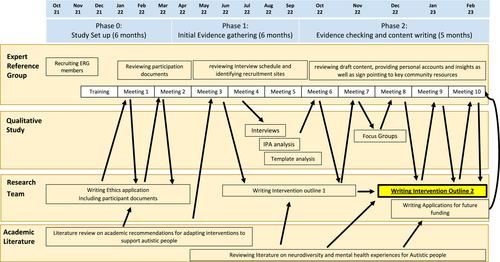The process of co-design for a new anxiety intervention for autistic children
Abstract
Background
Mental health difficulties are common for autistic people; however, almost no interventions have been co-designed with the autistic community. Co-design has the potential to add important insights from lived experience into intervention design, but there are currently limited examples of how rigorously to undertake this practice. This paper details a worked model of co-design and its process, focussed on adapting an evidenced parent-led intervention for non-autistic child anxiety (HYC), to meet the needs of young autistic children. The aim is to provide an example of co-design, integrating autistic, parental, academic, clinical, experience and expertise.
Methods
Using prior literature and theory, including Experience-Based Co-Design, we developed an iterative and collaborative process between the research team and an expert reference group (ERG). The research team comprised autistic and non-autistic members. The ERG included parents (autistic and non-autistic) of autistic children with anxiety problems, autistic adults with experience of anxiety problems, and clinicians with experience supporting autistic children with anxiety problems. The ERG and research team reviewed information from qualitative research interviews with autistic children with anxiety problems and their parents along with information from clinical experience and the academic literature to reach consensus on the adapted intervention design.
Results
The creation of a truly co-designed intervention that includes a neurodiversity-affirmative perspective, alongside CBT techniques. With anxiety problems experienced by autistic children being framed by combining the impacts of being neurodivergent in a neurotypical world, developmental science and well known cognitive behavioural models of child-anxiety.
Conclusion
Co-design can help to integrate multiple perspectives and result in the creation of interventions that are potentially relevant and acceptable to autistic people, their family members, and clinicians.





 求助内容:
求助内容: 应助结果提醒方式:
应助结果提醒方式:


